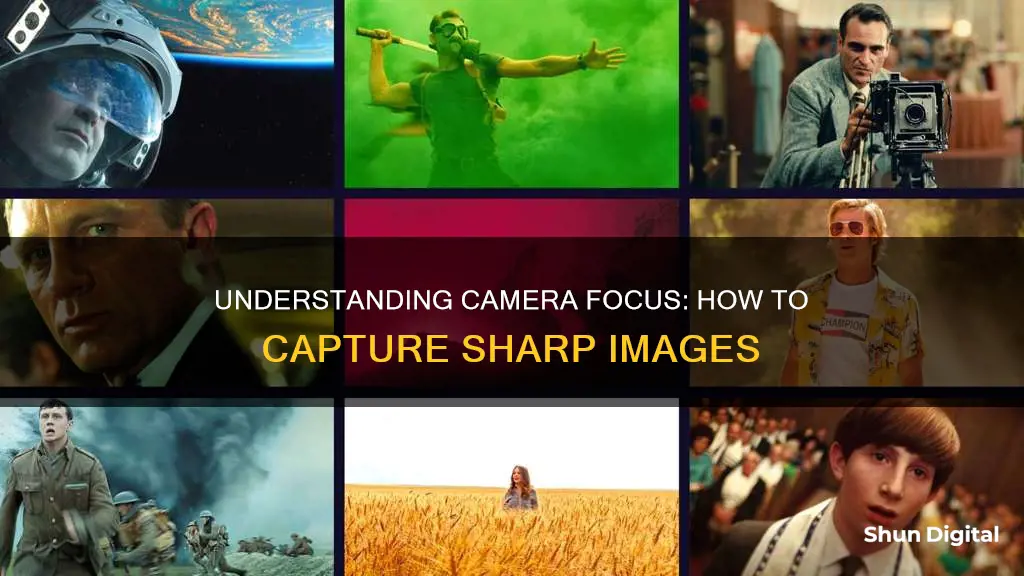
Camera focus is one of the most important techniques in photography. Without it, you'll end up with blurry photos even if all your other camera settings are correct.
In simple terms, focus is about finding the optimal sharpness of an object. It is the sharpest area of an image, where the lens works to highlight a person, object or situation.
There are two types of focus: manual and autofocus. In manual mode, the photographer has to turn the lens' focus wheel until the desired part of the image is in focus. Autofocus, on the other hand, is when the camera system automatically drives a motor to move elements in the lens to change focus.
There are various types of autofocus, including single-shot autofocus, continuous autofocus and predictive autofocus.
| Characteristics | Values |
|---|---|
| Focus modes | Manual, Autofocus (AF) |
| Autofocus modes | Single, Continuous, Hybrid |
| Manual focus use cases | Macro subjects, product photos, astrophotography, low-light conditions |
| Autofocus use cases | Moving subjects, wildlife, sports photography |
| Autofocus area modes | Single-point, dynamic area, auto area, 3D tracking |
What You'll Learn

Manual vs. autofocus
Overview
In photography, focus is the sharpest area of the image. It is the area where the lens works to highlight an object, a person, or a situation. Photographers can choose to focus manually or use the autofocus function on their camera.
Autofocus
Autofocus is a camera setting that makes the focusing process easier, especially for beginners or those who want to experiment with a type of photography that requires speed. Autofocus allows the camera to set the focal point, handling most of the work in ensuring a clear shot. It is generally quick, although its speed varies depending on the camera and lens type.
Autofocus is ideal for:
- Capturing moving subjects: Autofocus has seen advancements such as tracking, enabling it to lock focus on a subject and track it through the frame.
- Low-contrast scenes: Autofocus systems rely on contrast to identify objects. When this contrast is not present, such as in situations with heavy backlight, the ability of the autofocus system to focus is impeded.
- Capturing scenes with many objects: Autofocus is generally better suited for action scenarios, where there are multiple moving objects.
Manual Focus
Manual focus enables the user to set the focal point, providing more creative control over the image. It offers greater creative control as the user determines the focus point. This method is ideal for situations where autofocus may struggle, such as low-light conditions or shooting through glass or fences.
Manual focus is ideal for:
- Capturing magnified scenes: Autofocus systems generally perform poorly when capturing scenes with high magnification, such as in macro photography. Manual focus, on the other hand, is very precise and easy to use to pick out objects of interest from a chaotic scene.
- Capturing still images: Manual focus shines when capturing still images, especially in landscape photography, as it allows for more precise focusing on objects in the distance.
- Low-light conditions: Autofocus systems depend on light to determine where to focus and perform poorly in low-light conditions. Manual focus allows the user to precisely tell the camera where to focus, even in low-light conditions.
The choice between autofocus and manual focus largely depends on the photographer's needs and shooting conditions. Autofocus is generally faster and more convenient, while manual focus offers greater control and precision. Most photographers use autofocus more often, but it is beneficial to be familiar with both methods.
Browning Trail Cameras: Maximizing Battery Life
You may want to see also

Autofocus area modes
Single-Point AF Area Mode
Single-Point AF Area Mode is a straightforward method where the camera focuses solely on a single point selected by the photographer. This mode is ideal for stationary subjects or slow-moving subjects. It provides pinpoint accuracy, allowing you to ensure the camera focuses precisely where you want it to, such as on the eyes of your subject. Basic camera models typically offer a limited number of focus points, while advanced models provide a more extensive selection for greater precision. Regardless of the camera model, using the central focus points generally yields faster and more reliable results.
Dynamic AF Area Mode
Dynamic AF Area Mode is a versatile tool for photographers. It enables you to manually select an initial focus point, and if the subject moves, the camera automatically engages the surrounding focus points to maintain focus. This mode is particularly useful for wildlife and sports photography, where subjects are often in motion. The number of surrounding points utilised depends on the specific Dynamic AF Area Mode selected, with options typically including 9, 21, or 51 points. Some cameras, like the Nikon D810, even offer a Dynamic AF Area Mode with 3D tracking, which uses colour recognition to improve focus accuracy.
Group AF Area Mode
Group AF Area Mode is a valuable tool when you want to focus on a specific area or zone within the frame. It allows you to select a small group of autofocus points to ensure accurate focusing. This mode is well-suited for wildlife and sports photography, where you may want to focus on a group of subjects within a particular area. It is also useful for portrait photography when capturing group shots. Canon and Sony offer similar group area modes, providing autofocus face detection alongside the single autofocus mode.
Auto AF Area Mode
Auto AF Area Mode is a fully automatic mode that relinquishes control to the camera, allowing it to decide which focus points to use based on various factors. These factors include subject distances, motion relative to the camera, and the presence or absence of detectable eyes. While this mode is excellent for novice photographers or situations requiring quick focus, it may not be ideal when more precise control over the focus point is needed.
Understanding Shutter Priority Mode: Creative Control for Photographers
You may want to see also

Active vs. passive autofocus
There are two types of autofocus (AF) systems: Active and Passive. The "Active AF" system works by emitting a red beam of light onto the subject, then bouncing that light back to the camera to calculate the distance between the camera and the subject. Once the distance is known, the camera instructs the lens to adjust its focus accordingly. Active AF is useful in low-light environments where normal (passive) AF does not function. However, it is limited to stationary, non-moving subjects and only works for close subjects.
On the other hand, the "Passive AF" system operates differently. Instead of using a red beam to determine distance, it relies on "Phase Detection" or "Contrast Detection" (or a combination of both) to detect contrast.
Phase Detection vs. Contrast Detection
Most modern DSLR and mirrorless cameras can use both Phase and Contrast Detection to acquire focus. Let's understand how each of these works:
- Phase Detection AF: This type of autofocus uses an array of microlenses for focusing. Light passing through these microlenses is split into a pair of images. The distance between these images is measured to determine how far the subject is from the lens. The camera then uses this information to instruct the lens on how to adjust its focus. Phase Detection AF is very fast, making it ideal for tracking fast-moving subjects.
- Contrast Detection AF: Unlike Phase Detection, Contrast Detection relies on software algorithms that scan areas of an image for edge detail. The camera rapidly changes focus from foreground to background until the subject is sharply in focus. Due to this focus probing methodology, Contrast Detection AF is generally slower than Phase Detection. However, it can be more reliable and accurate in low-light conditions, which is why some cameras combine both methods in a "Hybrid AF" system.
Advantages and Disadvantages
- Active AF can work in low-light or dark environments, whereas Passive AF struggles in such conditions.
- Active AF is limited to stationary subjects and only works for close subjects. Passive AF has no such limitations.
- Passive AF, especially with Phase Detection, is generally faster and more suitable for tracking fast-moving subjects.
- Passive AF, with Contrast Detection, is more reliable and accurate in low-light conditions and can provide better results when shooting with larger apertures.
Moto Z Camera Mod: Compatibility and Fit
You may want to see also

Phase detection vs. contrast detection
Phase detection autofocus is very fast and good at tracking moving subjects. It doesn't require much computational work from your camera. However, it is more prone to errors and internal misalignment issues. Some cameras let you calibrate your phase detection system to minimize errors.
Phase detection works by splitting light into two separate images, each aimed at two lines on the autofocus sensor. If the images hit the two lines precisely, the subject is in focus. The distance between the two images tells the camera how much the lens is out of focus.
Contrast detection autofocus, on the other hand, requires your camera to process more data, which means it generally takes longer to lock focus. It works by analysing pixels on the camera's sensor and finding the point of highest contrast. As a result, it isn't good at tracking moving subjects. However, contrast detection does tend to be more precise, since the autofocus system is directly measuring the data from your camera sensor.
Contrast detection is also slower because it has to push the focusing point of the lens back and forth. It is also more accurate at focusing on still subjects. There is no need to calibrate your lens as there are no mechanical focusing errors.
Some cameras use a hybrid of the two systems. For example, a digital Single Lens Reflex (SLR) camera may use contrast detection autofocus in Live View or movie mode and phase detection autofocus when you look through the viewfinder.
Understanding Camera Focus: Capturing Sharp Images
You may want to see also

Depth of field
The depth of field can be controlled by adjusting the aperture. Large apertures, which correlate to small f-stop numbers, produce a very shallow depth of field. Conversely, small apertures, or large f-stop numbers, produce images with a large depth of field.
Another factor that affects depth of field is the distance between the camera and the subject. The shorter the distance, the smaller the depth of field. This is why it can be challenging to get the entire subject in focus when taking close-up shots, even with a small aperture.
Focal length also has an impact on depth of field. Wide-angle lenses (short focal lengths) generally have a deeper depth of field than telephoto lenses (long focal lengths). However, this comparison is not entirely fair, as the field of view is very different. If the camera-subject distance is adjusted so that the magnification of the subject remains the same, then the depth of field is the same, regardless of the focal length.
Sensor size also affects depth of field. Cameras with smaller sensors have larger depths of field. However, to make a valid comparison, one must look at cameras with lenses that have the same effective focal length, so that the fields of view are the same. When using the same camera-subject distance and aperture, larger sensors will have a shallower depth of field.
Camera Ticket Dispute: Proving Your Innocence
You may want to see also
Frequently asked questions
Camera focus is the process of making the selected part of a photo sharp. It is closely connected to the notion of the depth of field, which describes how "deep" the focus is and how many "layers" of the picture are sharp.
There are two main types of focus: manual and autofocus. Autofocus, as the name suggests, is when the camera automatically adjusts the sharpness with the help of an in-built motor.
There are two types of autofocus systems: phase detection and contrast detection. Phase detection is typically found on DSLR cameras and is very fast at tracking moving subjects. Contrast detection, on the other hand, is commonly used by mirrorless cameras and is more precise as it uses the light falling on the main sensor to provide focus.
Manual focus is typically used for static scenes where you have time to adjust the focus. Autofocus is used for moving subjects and can be further categorised into single-autofocus (AF-S) for slow-moving scenes and continuous autofocus (AF-C) for fast-moving subjects.
To achieve focus, you can either use autofocus by pressing the shutter button halfway or use the manual focus ring on your lens to adjust the focus until the desired part of the image is sharp.







